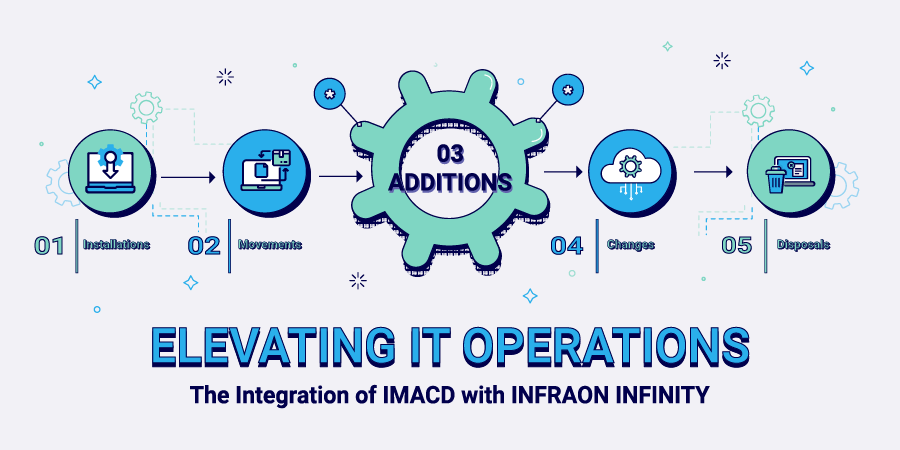Is it possible to transform IT management and elevate operations by integrating IMACD with Infraon Infinity? Does IMACD integration offer the transformative solution needed to adapt, streamline operations, and optimize IT management? This blog will give you insights into the significance and potential impact of merging IMACD with Infraon Infinity, exploring a new era of IT management excellence.
Definition of IMACD Process:
The IMACD process, which stands for Installations, Movements, Additions, Changes, and Disposals, is a comprehensive IT and asset management framework. It encompasses the entire lifecycle of IT assets within an organization.
- Installations: This phase deals with the initial deployment of new IT assets, including hardware and software. It involves setting up and configuring these assets to make sure that they are operational.
- Movements: Movements refer to relocating IT assets within an organization. This can involve physically moving equipment from one location to another or transferring digital assets between departments or users.
- Additions: Additions encompass acquiring and integrating new IT assets into the existing infrastructure. It includes procurement, setup, and configuration of these assets.
- Changes: Changes involve modifications and updates to existing IT assets. This can include software updates, hardware upgrades, or configuration changes to meet evolving business needs.
- Disposals: The disposal phase focuses on the responsible removal and disposal of outdated IT assets. It includes data wiping, recycling, or proper disposal to adhere to environmental and security regulations.
IMACD provides a structured approach to managing IT assets, ensuring that they are deployed, relocated, added, modified, and disposed of in compliance with organizational requirements and industry standards. This comprehensive process aids organizations in optimizing their IT asset management and maintaining a well-organized and secure IT infrastructure.
Related blog: The Ultimate IMACD Process Guide for Seamless Transitions in 2023
Why IMACD Matters in IT?
The IMACD process is vital in IT as it enables the organized management of IT resources. It controls costs and secures compliance by systematically handling IT asset installation, movement, addition, modification, and deletion. This process is necessary for aligning IT environments with evolving organizational needs and goals.
- Adaptation to IT Dynamics: In information technology, organizations need the agility to adapt to evolving IT requirements. IMACD enables businesses to accommodate new technologies, configurations, and changes easily.
- Optimized Resource Utilization: IT asset management is crucial for optimizing resource allocation. IMACD guarantees that resources are utilized, reducing waste and redundancy, ultimately leading to cost savings.
- Minimized Downtime: Downtime in IT operations can be costly and disruptive. IMACD minimizes downtime by simplifying processes, ensuring that changes and additions are carried out seamlessly without extended interruptions.

- Compliance and Data Security: Adherence to regulatory standards and data security are non-negotiable in the IT landscape. IMACD assures compliance with changes and disposals, reducing the risk of security breaches and regulatory violations.
- Competitiveness and Innovation: The ability to manage IT assets directly impacts an organization’s competitiveness. With IMACD, businesses can focus on innovation and meeting customer demands instead of addressing IT management challenges.
In summary, IMACD matters in IT because it enables organizations to adapt and thrive in the dynamic world of information technology. It empowers businesses to leverage technology for competitive advantage while ensuring compliance and data security.
Overview of Infraon Infinity:
Infraon Infinity is a comprehensive and integrated IT product tailored to meet the distinct requirements of enterprises, regardless of their size. Within the evolving landscape of IT operations, where the need for modernization is constant, Infraon simplifies managing IT assets, handling incidents, resolving support tickets, and managing customer information through an intuitive, user-friendly interface.
Infraon Infinity addresses ITOPs modernization, legacy systems, cloud, and hybrid IT complexities while optimizing resource allocation and reducing troubleshooting time. Its comprehensive platform empowers agility and competitiveness. AI and ML integration offers intuitive data management, and strict data security is maintained through GDPR compliance and SOC2 certification. With dedicated support teams and three months of post-deployment support, Infraon Infinity revolutionizes operations management, introducing a novel approach to ITAM and ITSM.
Components of Infraon Infinity
The Infraon Infinity boasts diverse components designed to address specific facets of IT management. Here’s a more in-depth exploration of each component’s role and significance within the suite:
- Infraon Helpdesk: The Infraon Helpdesk is the frontline for IT service support. It is a centralized system for tracking and managing service requests and incidents. This component improves communication between end-users and IT teams, ensuring that issues are promptly identified, resolved, and tracked. It is integral in enhancing user satisfaction and maintaining smooth IT service operations.
- Infraon Assets: Planned asset management is necessary for IT operations. Infraon Assets manages IT assets, encompassing hardware, software, licenses, and warranties. It offers comprehensive visibility into the entire asset lifecycle, aiding organizations in allocating resource allocation, ensuring compliance, and controlling costs.
- Infraon ITSM: ITSM represents a comprehensive approach to managing IT services. Infraon ITSM integrates various service management processes, including service request handling, incident management, problem resolution, and change management. It aligns IT services with business requirements, ensuring they are delivered efficiently and effectively.
- Infraon NMS: Network stability and security are necessary in today’s digital landscape. Infraon NMS specializes in network management, offering tools for monitoring, configuring, and optimizing network resources. It aids organizations in maintaining the integrity and performance of their network infrastructure.
- Infraon Uptime: Uptime is a critical metric for measuring service availability. Infraon Uptime management focuses on tracking and maximizing uptime for crucial IT systems. Reducing the risk of service disruptions results in vital services remaining accessible and operational.
Each component within the Infraon addresses specific IT management needs, offering organizations a comprehensive product to resolve their workflows and improve overall IT operations. Whether optimizing asset management, ensuring service availability, or managing network resources, the Infraon components empower organizations to excel in the digital age.
How does Infraon Contribute to Streamlined IT Management?
Infraon, as a comprehensive IT product suite, is essential in reshaping streamlined IT management. Its multifaceted components and integrated approach bring about a multitude of benefits and contributions to IT operations:
- Streamlined Workflows: Infraon simplifies IT operations by streamlining workflows. It eliminates the need for manual, time-consuming tasks and automates routine processes. This boosts productivity and reduces the risk of human error.

- Real-time Monitoring: Infraon provides real-time monitoring capabilities through its Infrastructure Management System (IMS). This allows IT professionals to keep an eye on network health and performance. Any potential issues are immediately detected, enabling proactive interventions.
- Incident Resolution: The Infraon Helpdesk facilitates incident resolution when incidents occur. It certifies that service requests and incidents are optimally managed, minimizing downtime and enhancing user satisfaction.
- Resource Optimization: The asset management component, Infraon Assets, empowers organizations to maximize resource allocation. Keeping a detailed record of IT assets establishes that assets are utilized, and costly underutilization is minimized.
- Agility and Adaptability: Infraon is designed to adapt to changing IT landscapes. It accommodates the scaling and growth of IT resources, ensuring that organizations remain agile and responsive to evolving technology requirements.
- Data-driven Decision Making: Infraon provides advanced analytics and reporting tools that empower organizations to make data-driven decisions. This is invaluable for strategic planning, capacity management, and optimizing resource allocation.
- Regulatory Compliance: Compliance with industry regulations and organizational policies is crucial for many businesses. Infraon helps maintain compliance by ensuring that assets and changes adhere to predefined rules and standards.
In conclusion, Infraon’s contributions to IT management are multifaceted: automation, real-time monitoring, incident resolution, resource optimization, agility, data-driven decision-making, compliance, security, and environmental responsibility. Its integrated approach makes IT operations agile and aligned with organizational objectives.
Impact of Infraon Infinity Across Industries
Here’s how Infraon’s capabilities cater to the unique needs and challenges of across various industries:
- Healthcare Sector: In healthcare, data security, patient information management, and compliance with regulatory standards like HIPAA are critical. Infraon guarantees the confidentiality and integrity of healthcare data while optimizing IT operations. It aids in allocating resource allocation, enhancing the service quality of healthcare facilities, and providing a seamless patient experience.
- Financial Services: The financial sector demands top-notch security, compliance, and rapid responses to changing market conditions. Infraon’s real-time monitoring and incident resolution capabilities are invaluable for protecting sensitive financial data. Its compliance features ensure adherence to financial regulations, and its agility supports quick adaptation to market changes.

- Manufacturing Industry: Manufacturing relies on operations and minimal downtime. Infraon’s asset management and uptime optimization features are crucial for maintaining the smooth functioning of production facilities. It helps track machinery health, timely maintenance, and maximize uptime.
- Government and Public Sector: Government organizations handle sensitive data and must secure IT operations’ security and reliability. Infraon’s security and compliance features align with government standards, while its real-time monitoring and automation support service delivery to citizens.
- Telecommunications: The telecommunications sector relies on network stability and quick responses to service disruptions. Infraon’s network management capabilities are critical for ensuring continuous connectivity and optimizing network resources.
Bridging IMACD and Infraon: A Step towards Enhanced IT Operations
In the modern network management landscape, integrating IMACD and Infraon is pivotal to achieving enhanced IT operational excellence. Critical actions and considerations must be addressed to successfully embark on this transformative journey. This section provides a comprehensive exploration of the key aspects involved in bridging IMACD and Infraon:
A. Pre-integration Considerations
1. Assessment of Current Infrastructure: A thorough examination of the current IT infrastructure is imperative before embarking on the integration journey. This includes identifying all network components, configurations, and the existing IMACD processes. This initial assessment serves as the foundation for a successful integration.
2. Defining Objectives: Clear and specific objectives for the integration must be outlined. Are you looking to optimize IMACD processes, encourage data security IT resource allocation, or achieve broader operational efficiency? Defining these objectives guides the integration process and ensures the desired outcomes are met.
3. Resource Allocation: Adequate resource allocation is critical for the integration project’s success. This includes allocating the necessary personnel, time, and budget to confirm the integration is carried out adequately.
4. Compliance and Security: Evaluating the integration’s compliance requirements and security implications is essential. Ensuring that the integrated system complies with relevant industry standards and regulations and that data security is maintained is a non-negotiable aspect of the process.
B. Possible Integration Pathways: IMACD and Infraon
Integration pathways are the routes through which IMACD and Infraon converge to operate as a unified product. These pathways may include:
1. API Integration: Utilizing Application Programming Interfaces (APIs) to establish seamless communication between IMACD and Infraon. This approach enables data exchange, real-time functionality synchronization, and information sharing between the two systems.
2. Custom Integration: Crafting custom connectors or scripts to bridge IMACD and Infraon based on the organization’s specific requirements. Custom integration offers a high degree of flexibility, allowing organizations to adapt to their unique needs.
3. Middleware Solutions: Leveraging middleware platforms that act as intermediaries between IMACD and Infraon, facilitating smooth communication and data flow. These middleware solutions serve as connectors that simplify the integration process.
C. Post-integration Optimizations: Maximizing the Benefits
Once the integration of IMACD and Infraon is successfully implemented, it transitions into the phase of post-integration optimizations. These optimizations are instrumental in maximizing the benefits of this amalgamation:
1. Continuous Monitoring: Implementing robust monitoring tools to monitor the integrated systems. Continuous monitoring ensures the systems operate seamlessly while promptly identifying and addressing any issues or discrepancies.
2. User Training and Adoption: Continuing to provide training and support to users and IT staff is crucial for ensuring they fully harness the capabilities of the integrated system. This ongoing training helps in enhancing user proficiency and adoption.
3. Scalability: Preparing for future growth and expansion is vital. Assessing scalability options ensures that the integrated solution can accommodate evolving IT needs and adapt to the organization’s changing requirements.
4. Data Analytics: Leveraging the combined data generated by the integrated IMACD and Infraon systems to gain actionable insights. This data analytics process empowers organizations to make informed decisions, upgrade IT operations, and drive further improvements.
Conclusion:

Integrating IMACD with the Infraon can improve IT operations and redefine management standards. This integration enables organizations to seamlessly adapt to the IT dynamics while upholding strict compliance, minimizing disruptive downtime, and fostering innovation.
The Infraon Infinity, a comprehensive, integrated IT product, catalyzes IT operations, enhances agility, enforces compliance measures, and promotes data-driven decision-making. Its adaptability extends to various sectors, ensuring tailored solutions for IT management needs.
From thorough pre-integration planning to selecting suitable integration pathways and post-integration optimization, this process culminates in a secure and well-managed IT environment. This transformative journey elevates overall organizational performance and competitiveness, paving the way new era of IT management excellence aligned with the dynamic technology advancements.



















